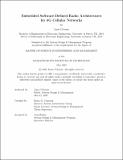Embedded Software-Defined Radio Architectures for 6G Cellular Networks
Author(s)
Urbonas, Jonas
DownloadThesis PDF (16.92Mb)
Advisor
Cameron, Bruce G.
Terms of use
Metadata
Show full item recordAbstract
Over the past decades, the widespread adoption of wireless communication technologies in the industrial, scientific, medical, defense, and commercial sectors has resulted in substantial advancements in digital radio technologies. Each new generation of cellular technology, beginning with 1G, has introduced novel use-case scenarios that have challenged the performance of the prevailing digital radio architectures. The newly proposed scenarios for 5G-Advanced, and the upcoming 6G cellular networks due to be standardized by 2030 are no exception. The emerging 6G network components, such as the space-air-ground integrated cell-less networks, as well as the artificial intelligence-native network architecture, drive the demand for flexible and fully reconfigurable radio units supporting multi-GHz instantaneous signal bandwidths, frequency agile radio architectures covering multi-octave frequency ranges, and highly sensitive receivers.
To support these requirements, software-defined radios (SDR) are becoming an essential building block of next-generation radio networks. This thesis presents a review of softwaredefined radio technology, examines its history, proposes the requirements of SDR units for 6G cellular networks, and presents a quantitative performance analysis of over 2 million distinct SDR architectures that could be used in 6G communication networks. It does so by defining the key system architectural decisions and their options, including the data converters, filters, mixer and amplifier technologies. It also examines different radio transmitter and receiver architectural topologies, including baseband sampling, IF sampling, direct RF sampling, and fully digital RFSoC, and constructs a multi-attribute utility (MAU) to quantify the system performance. The MAU is used to build a tradespace of SDR architectures, enabling the identification of the Pareto frontier. Analysis of SDR system architectures on the Pareto frontier reveals that the performance of direct RF sampling SDR architectures is highly competitive with industry-standard IF sampling. The tradespace is also used to analyze the sensitivity of system performance to individual architectural decisions via a main-effect analysis, allowing quantification of connectivity and sensitivity of available architectural decisions. Sensitivity analysis reveals that system performance is highly sensitive to receiver architectural decisions, particularly analog-to-digital converters, indicating the need for continued advances in this technology to produce high-performance SDR systems.
Date issued
2025-05Department
System Design and Management Program.Publisher
Massachusetts Institute of Technology